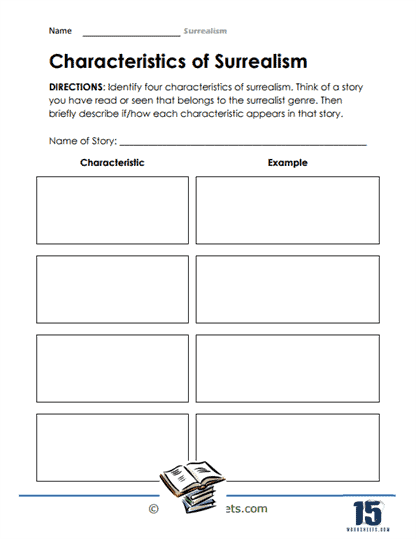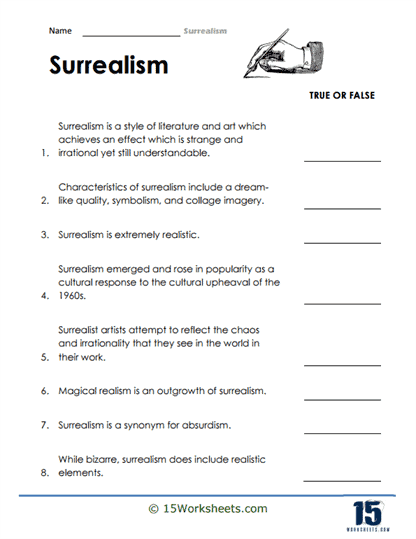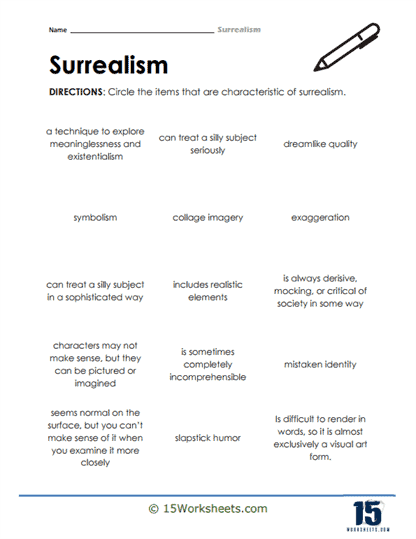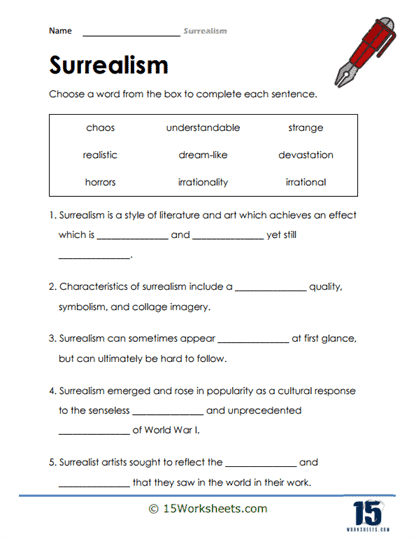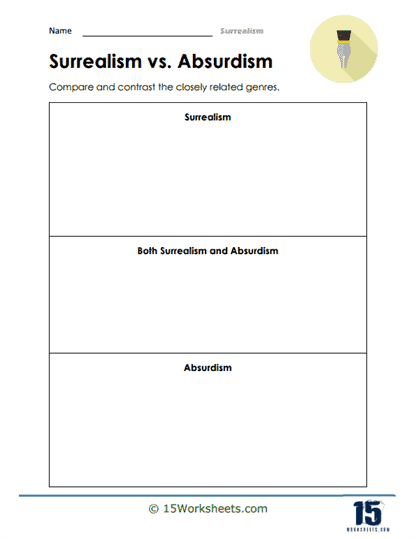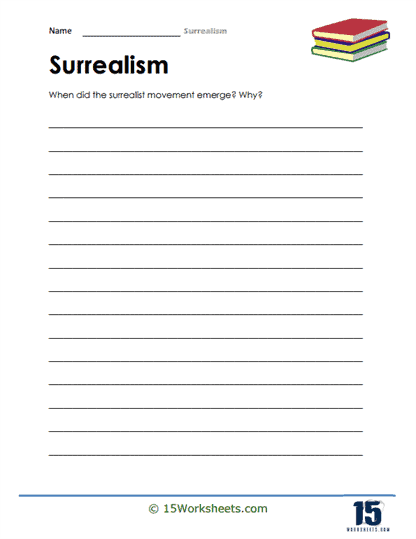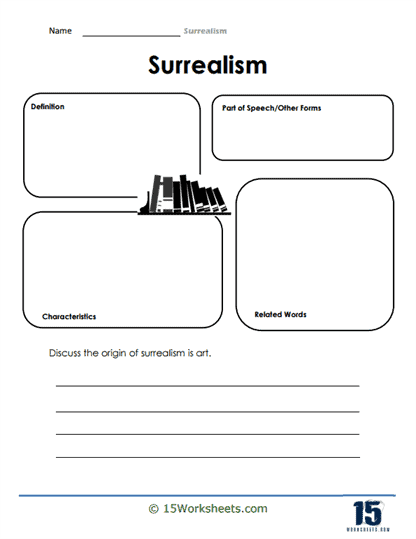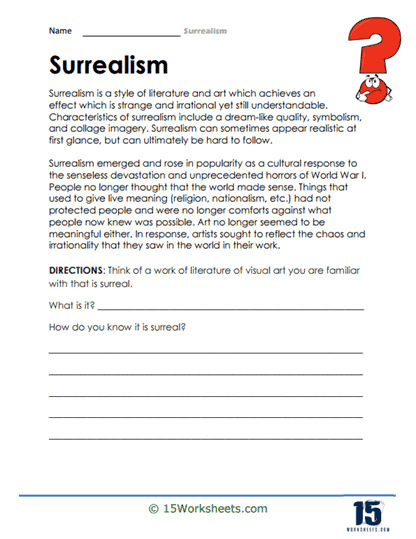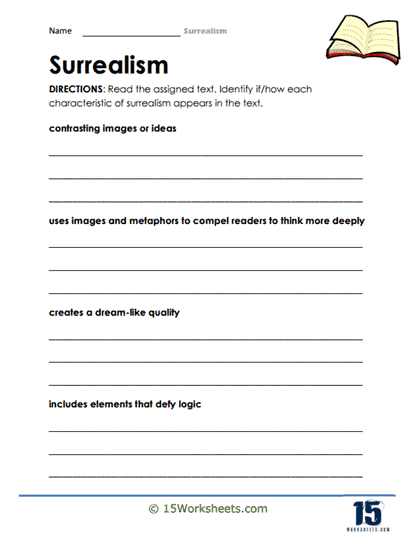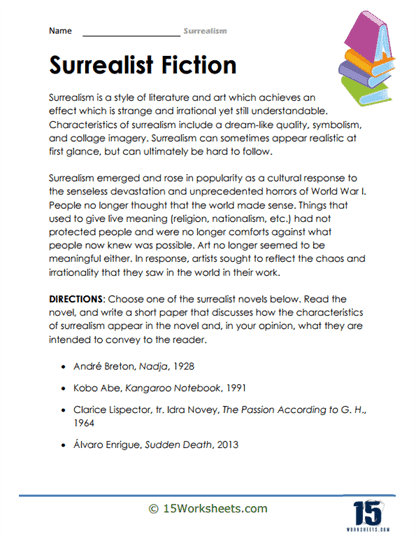Surrealism Worksheets
All About These 15 Worksheets
Surrealism, an artistic and literary movement that explores the irrational and dreamlike realms of the subconscious, is a captivating and influential genre that challenges conventional thinking and stimulates creativity. Understanding surrealism is not only important for artistic and literary appreciation but also for fostering imagination, critical thinking, and a deeper understanding of the human psyche. This collection of 15 worksheets is designed to introduce students to the world of surrealism, helping them grasp the importance of this artistic movement, recognize its various forms, and cultivate their own creative and analytical skills.
What Are Surrealism Worksheets?
These worksheets were written to help students learn and understand the concept of surrealism, an artistic and literary movement that began in the early 20th century. This movement is known for its emphasis on releasing the creative potential of the unconscious mind, resulting in unusual, dreamlike, or illogical scenes and images.
Here’s what you might find in these worksheets:
Definition and Identification – The worksheets would begin with an explanation of surrealism, its origins, and its key characteristics. This would include an exploration of how surrealism blends reality with dreamlike or fantastical elements. Then, students might be asked to identify examples of surrealism in provided images, paragraphs, or poems.
In Literature – Given surrealism’s profound influence on both art and literature, some exercises might ask students to analyze examples from famous surrealist artists like Salvador Dali or writers like Andre Breton. They could be asked to identify and discuss the surreal elements in these works.
Creating Surrealist Writing – Some exercises could encourage students to create their own surrealistic art or writing. For instance, they might be asked to write a short poem that incorporates dreamlike or illogical sequences, or to sketch an image that blends reality and fantasy.
Exploring Surrealist Techniques – Surrealists used certain techniques to tap into the unconscious mind, such as automatic drawing or writing, and the exquisite corpse game. Worksheets could provide instructions for these techniques and space for students to try them out.
Interpreting Surrealist Works – Since surrealism often involves complex symbolism and personal imagery, some exercises might focus on interpretation. Students might be asked to speculate on the possible meanings behind a given surrealist work, encouraging them to think critically and imaginatively.
In short, the goal of these worksheets would be to familiarize students with surrealism and its techniques, helping them recognize and understand this significant artistic movement. Understanding surrealism can enrich students’ understanding of art and literature, and open up new avenues for their own creativity.
What is the Literary Device of Surrealism?
Surrealism, originating from the art movement of the same name in the 1920s, is a literary device and style that seeks to transcend the limits of reality by embracing the irrational and exploring the subconscious mind. The primary focus of Surrealism is to blur the boundaries between the real and the imaginary, the conscious and the unconscious, to evoke a dreamlike, often unsettling atmosphere.
Defining Features of Surrealism
The defining features of Surrealism are its disregard for rationality and logic, and its exploration of the bizarre, the dreamlike, and the extraordinary. This style often includes illogical scenarios, absurd humor, juxtaposition of disparate objects or ideas, and exploration of the uncanny. It also seeks to unleash creativity by accessing and utilizing the subconscious mind, influenced by Sigmund Freud’s psychoanalytical theories.
How Authors Use Surrealism
Authors use Surrealism as a way to provoke readers into a deeper engagement with the text by challenging their conventional understanding of reality. Surrealist texts can lead readers to consider new perspectives and to question their preconceptions. By presenting a world that defies rational understanding, these texts invite readers into an imaginative, often disorientating, engagement with the story, thereby enhancing their reading experience.
Examples of Surrealism in Literature
“Kafka on the Shore” by Haruki Murakami
Haruki Murakami is known for his surrealistic style. “Kafka on the Shore” is an exemplary piece where he creates a fantastical world that intermingles with reality. In the novel, fish rain from the sky, a man can converse with cats, and characters slip in and out of different realms and times. By doing this, Murakami encourages readers to abandon the constraints of logic and reality, and to embark on an imaginative journey through the novel’s dreamlike landscapes.
“One Hundred Years of Solitude” by Gabriel Garcia Marquez
This novel is a classic example of magical realism, a subgenre of Surrealism. The story spans seven generations of the Buendía family in the mythical town of Macondo. The surreal elements – such as the rain of yellow flowers, a girl ascending to heaven while folding the laundry, and the propagation of the Aurelianos across generations – blend seamlessly with the narrative’s reality, creating a sense of uncanny wonder and estrangement.
“Naked Lunch” by William S. Burroughs
This novel is a non-linear series of vignettes, following the experiences of a drug addict. The narrative is chaotic, disturbing, and filled with bizarre and nightmarish scenarios, reflecting the surreal and disjointed perceptions of a drug-addled mind. The book serves as a critique of both the societal structures of control and the individual’s willingness to succumb to them, using surrealistic elements to vividly portray this struggle.
Benefits Of Surrealism Worksheets To Students
Exploring the world of surrealism through this collection of 15 mind-bending worksheets offers students an opportunity to develop essential skills in artistic appreciation, imagination, critical thinking, psychological insight, and cultural and historical awareness. Surrealism is a genre that invites students to break free from conventional thinking and explore the mysteries of the subconscious mind.
By engaging with these exercises and activities, students not only enhance their academic abilities but also gain valuable tools for creative expression, unconventional thinking, and a deeper understanding of the complexities of the human psyche. The benefits of studying surrealism extend far beyond the classroom, empowering students to be more imaginative, open-minded, and culturally aware individuals in an increasingly complex and creative world.


